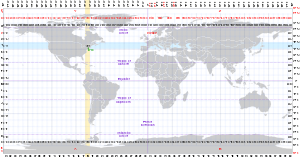Easting and northing
Easting and northing are geographic Cartesian coordinates for a point. Easting is the eastward-measured distance (or the x-coordinate) and northing is the northward-measured distance (or the y-coordinate). When using common projections such as the transverse Mercator projection, these are distances projected on an imaginary surface similar to a bent sheet of paper, and are not the same as distances measured on the curved surface of the Earth.

Easting and northing coordinates are commonly measured in metres from the axes of some horizontal datum. However, other units (e.g., survey feet) are also used. The coordinates are most commonly associated with the Universal Transverse Mercator coordinate system (UTM), which has unique zones that cover the Earth to provide detailed referencing.
Notation and conventions
Locations can be found using easting/northing (or x, y) pairs. The pair is usually represented conventionally with easting first, northing second.
For example, the peak of Mount Assiniboine (at 50°52′10″N 115°39′03″W) in UTM Zone 11 is represented by 11U 594934 5636174. Other conventions can also be used, such as a truncated grid reference,[1] which would shorten the example coordinates to 949-361.
Negative northing and easting values indicate a position due south and west of the origin, respectively.
Usually associated with a map projection is a natural origin, e.g., at which the ellipsoid and flat map surfaces coincide.[2] To ensure that the northing and easting coordinates on a map are not negative, map projections may set up a false origin, specified in terms of false northing and false easting values, that offset the true origin.
See also
- East north up
- Horizontal plane
References
- "Truncated Grid References". Bivouac.com – Canadian Mountain Encyclopedia. 2006-11-17.
- "Geomatics Guidance Note Number 7, part 2 Coordinate Conversions and Transformations including Formulas" (PDF). International Association of Oil and Gas Producers (OGP). pp. 9–10. Archived from the original (PDF) on 6 March 2014. Retrieved 5 March 2014.